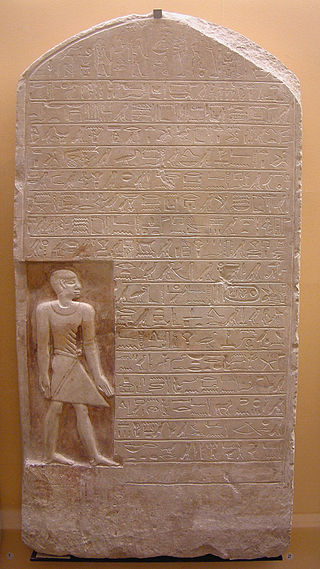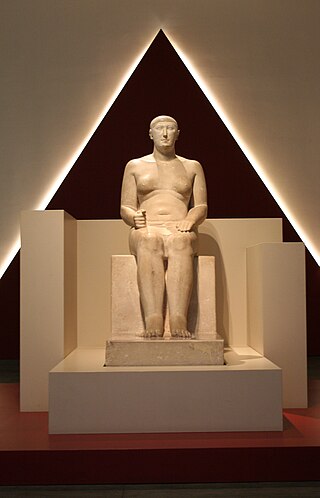Aya was an ancient Egyptian king's wife of the early Thirteenth Dynasty (between 1803 and 1649 BCE). [1]
Contents
| Aya in hieroglyphs | |||||
|---|---|---|---|---|---|
| Era: Middle Kingdom (2055–1650 BC) | |||||

Aya was an ancient Egyptian king's wife of the early Thirteenth Dynasty (between 1803 and 1649 BCE). [1]
| Aya in hieroglyphs | |||||
|---|---|---|---|---|---|
| Era: Middle Kingdom (2055–1650 BC) | |||||

She is known from two sources. She can be associated with vizier Ankhu.
At Abydos, Aya appears on a stela now in Würzburg. [2] [3] From this source it is clear that she was part of an influential family of high court officials and was related to the Vizier . [1] [4] Importantly, is a certain Royal Scribe and Overseer of a Half-Domain, Wepwawethotep {ḫtmw-bjtj; jmj-rꜣ gs-pr wp-wꜣwt-ḥtp}, who married Senebhenas, daughter of Vizier Ankhu.
She appears in the Papyrus Boulaq 18. [3] This is an administrative account belonging to the Theban palace of a Thirteenth Dynasty king. It was found in the tomb of the scribe of the great enclosure Neferhotep. The name of the king in this papyrus is only partly preserved. [1]
High officials mentioned in this text includes Vizier Ankhu and High Steward Aabeni.
Many scholars read the remains of the king's name in the Papyrus Boulaq 18 as Sekhemre Khutawy Sobekhotep. [1] However, the reading is disputed and other suggestions include King Sehetepkare Intef and King Imyremeshaw. [3] Therefore, there is some doubt over the identification of Aya's husband. [1]

Merneferre Ay was an ancient Egyptian pharaoh of the mid 13th Dynasty. The longest reigning pharaoh of the 13th Dynasty, he ruled a likely fragmented Egypt for over 23 years in the early to mid 17th century BC. A pyramidion bearing his name shows that he possibly completed a pyramid, probably located in the necropolis of Memphis.

The Middle Kingdom of Egypt is the period in the history of ancient Egypt following a period of political division known as the First Intermediate Period. The Middle Kingdom lasted from approximately 2040 to 1782 BC, stretching from the reunification of Egypt under the reign of Mentuhotep II in the Eleventh Dynasty to the end of the Twelfth Dynasty. The kings of the Eleventh Dynasty ruled from Thebes and the kings of the Twelfth Dynasty ruled from el-Lisht.

Pepi II Neferkare was a pharaoh of the Sixth Dynasty in Egypt's Old Kingdom who reigned from c. 2278 BC. His second name, Neferkare (Nefer-ka-Re), means "Beautiful is the Ka of Re". He succeeded to the throne at age six, after the death of Merenre I.

The Turin King List, also known as the Turin Royal Canon, is an ancient Egyptian hieratic papyrus thought to date from the reign of Pharaoh Ramesses II, now in the Museo Egizio in Turin. The papyrus is the most extensive list available of kings compiled by the ancient Egyptians, and is the basis for most chronology before the reign of Ramesses II.

The Twelfth Dynasty of ancient Egypt is considered to be the apex of the Middle Kingdom by Egyptologists. It often is combined with the Eleventh, Thirteenth, and Fourteenth dynasties under the group title, Middle Kingdom. Some scholars only consider the 11th and 12th dynasties to be part of the Middle Kingdom.

Smenkhkare Imyremeshaw was an Egyptian pharaoh of the mid 13th Dynasty during the Second Intermediate Period.

Sehetepkare Intef was the twenty-third king of the 13th Dynasty during the Second intermediate period. Sehetepkare Intef reigned from Memphis for a short period, certainly less than ten years, between 1759 BC and 1749 BC or c. 1710 BC.

Sekhemre Khutawy Amenemhat Sobekhotep was an Egyptian pharaoh of the early 13th Dynasty.

Usermaatre Setepenamun Takelot III Si-Ese was Osorkon III's eldest son and successor. Takelot III ruled the first five years of his reign in a coregency with his father, according to the evidence from Nile Quay Text No.13, and succeeded his father as king the following year. He served previously as the High Priest of Amun at Thebes. He was previously thought to have ruled Egypt for only 7 years until his 13th Year was found on a stela from Ahmeida in the Dakhla Oasis in 2005.

Ankhu was an Egyptian vizier of Upper Egypt during the early 13th Dynasty, who lived around 1750 BC. He is believed to have resided in Thebes.

The vizier was the highest official in ancient Egypt to serve the pharaoh (king) during the Old, Middle, and New Kingdoms. Vizier is the generally accepted rendering of ancient Egyptian tjati, tjaty etc., among Egyptologists. The Instruction of Rekhmire, a New Kingdom text, defines many of the duties of the tjaty, and lays down codes of behavior. The viziers were often appointed by the pharaoh. During the 4th Dynasty and early 5th Dynasty, viziers were exclusively drawn from the royal family; from the period around the reign of Neferirkare Kakai onwards, they were chosen according to loyalty and talent or inherited the position from their fathers.

Ancient Egyptian literature was written in the Egyptian language from ancient Egypt's pharaonic period until the end of Roman domination. It represents the oldest corpus of Egyptian literature. Along with Sumerian literature, it is considered the world's earliest literature.

Mereruka served during the Sixth Dynasty of Egypt as one of Egypt's most powerful officials at a time when the influence of local state noblemen was increasing in wealth and power. Mereruka held numerous titles along with that of Vizier, which made him the most powerful person in Egypt after the king himself. Among the other official positions that Mereruka held were "Director of all the king's works," "Governor of the palace," "Chief lector-priest," "Overseer of the royal record scribes," and "Inspector of the priests attached to the pyramid of Teti." He was married to Seshseshet Waatetkhethor, daughter of King Teti. His mother was named Nedjetempet and he possibly had a brother named Ihy, though this may be the same individual as Ihyemsaf, his grandson.
The Papyrus Boulaq 18 is an ancient Egyptian administrative document. It contains an account of the Theban palace dating to the 13th Dynasty. The papyrus lists the palace officials and the rations they received day by day. Important officials mentioned are, for example, the vizier Ankhu, but also the queen Aya. Therefore, the document is of great historical importance. It also reports the journey of the king to the temple at Medamud and reports the arrival of a delegation of Nubians.

Zamonth or Samont was an ancient Egyptian vizier who is thought to have been in office during the reign of Amenemhat III, at the end of the Twelfth Dynasty.
This page list topics related to ancient Egypt.

Sobekemsaf was an ancient Egyptian official of the Thirteenth Dynasty, around 1700 BC. He is especially well known from his statue in Vienna.

Aabeni was an ancient Egyptian official with the title high steward. He was one of the most important officials at the royal court in the early Thirteenth Dynasty.
Dedusobek Bebi was a high official of the late Thirteenth Dynasty of ancient Egypt. He became the "Great Scribe of the Vizier". This position was directly under the Vizier acting as a deputy.
Resseneb was a short-lived vizier in Upper Egypt during the 13th Dynasty, preceded by his father, the famous Ankhu, and succeeded by his brother Iymeru.